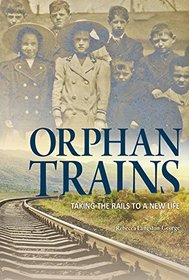Orphan Trains: Taking the Rails to a New Life by Rebecca Langston-George
Review by jjares
Because I read a lot of historical fiction, I’m familiar with the ‘orphan trains’ of the 1800s to the early 1900s. I’m used to reading about them taking homes in the West. However, I wanted to learn about them from the beginning point, usually New York City. Why were there so many available to go on the trains to the West? What were their stories? Although this book is written for children, it answered my questions well.
In 1853, Charles Loring Brace, a young minister, was dismayed by the 30,000 orphaned children wandering about in New York City alone. Partly, this was caused by the significant influx of immigrants to America and the lack of vaccines to protect people from illnesses. In addition, with poor sanitation and hygiene, there was a high death rate among adults, leaving abandoned children.
Brace and other ministers allied to address the problem. The orphanages were overwhelmed, and many more children lived in the streets however they could manage. So Brace founded the Children’s Aid Society. After gathering donations, the group opened schools and lodgings. The group started with the newsboy, giving them accommodation and a way to save their pennies (earned selling newspapers), so they could continue their independence. Still, there were so many children.
Brace realized the children would be better served by letting them live on farms with families. Twenty-eight of the thirty-seven children were adopted on the first orphan train in 1854. Each child was bathed, groomed, given new clothes and shoes, and placed on the train. This book tells the individual stories of children looking for a home.
Along the train line, flyers were posted to let people know when the orphans would arrive. Prospective adults were screened and told that the children were not indentured servants but were free to leave if ill-treated or dissatisfied. Likewise, the farmers could dismiss the children if they were lazy or unsuitable.
After telling several individual stories, this book gives closing remarks on those personal lives — and they are fascinating. About 250,000 children moved westward in the largest migration of children in history. Amongst those survivors, there were two governors, a congressman, a sheriff, at least one mayor, some district attorneys, doctors, lawyers, bankers, teachers, business owners, and one nun.
This book tells stories of a little-known segment of our history. With the photos and individual narratives, this book will affect the reader. This author indicates that PBS did a documentary about orphan trains. There are also orphan train museums, reunions, and websites.


